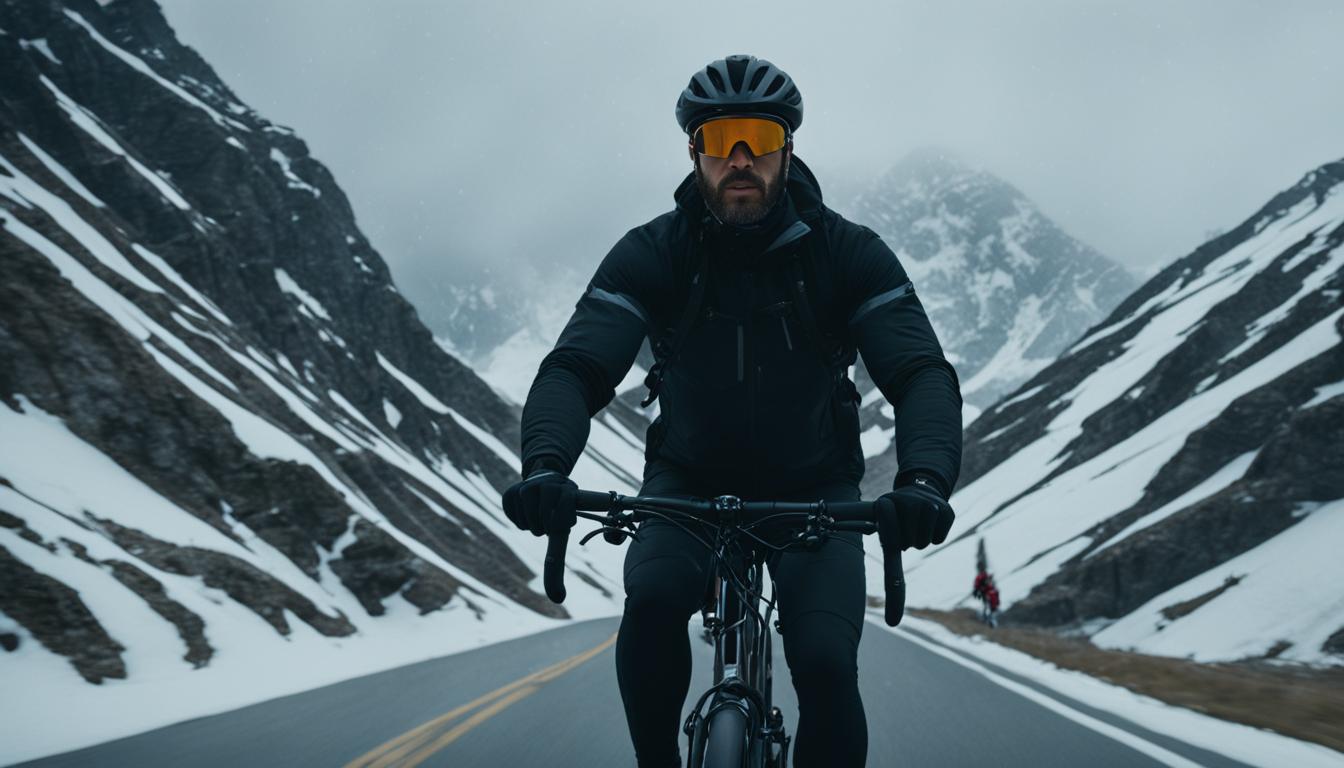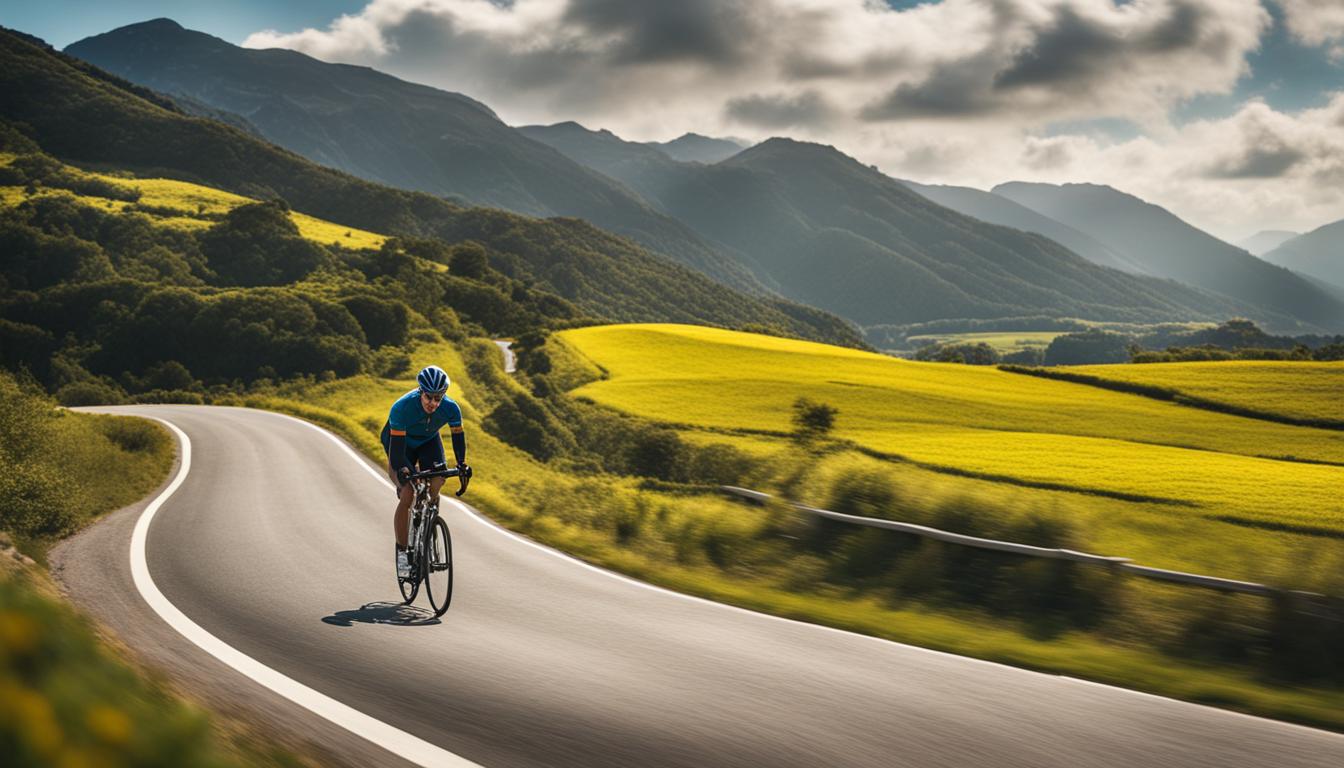When cycling in temperatures around 50 degrees, it’s important to dress appropriately to stay warm and comfortable on your ride. The right clothing can make all the difference in keeping you safe and allowing you to enjoy your cycling experience even in colder weather.
Here are some winter cycling tips to help you choose the best gear for cold weather cycling:
Key Takeaways:
- Layering is essential when dressing for 50 degrees Fahrenheit cycling.
- Consider wearing tights or leg warmers, a long-sleeve jersey with a sleeveless or short-sleeve undershirt, thin full-fingered gloves, and a headband to cover your ears.
- Wool socks, shoe covers, and proper footwear will help keep your feet warm during your ride.
- Adjust your attire based on the weather conditions, and add heavier layers when necessary.
- Pay attention to wind, sun exposure, and your personal comfort level when choosing your clothing.
Dressing for 50 Degrees Fahrenheit Cycling
When it comes to cycling at 50 degrees Fahrenheit, choosing the right clothing is essential to ensure a comfortable and enjoyable ride. Coach David Ertl recommends the following clothing options:
- Tights or Leg Warmers: To keep your legs warm and protected, opt for tights or leg warmers that provide insulation.
- Heavy Long-Sleeve Jersey: A heavy long-sleeve jersey is a great choice as it offers warmth and insulation while allowing for breathability during your ride.
- Sleeveless or Short-Sleeve Wicking Undershirt: Layering is key to staying warm, and a sleeveless or short-sleeve wicking undershirt helps regulate your body temperature while wicking away moisture.
- Lightweight Long-Sleeve Jersey: Alternatively, you can opt for a lightweight long-sleeve jersey combined with a long-sleeve undershirt to provide warmth without overheating.
- Thin Full-Fingered Gloves: Keep your hands warm and maintain dexterity by wearing thin full-fingered gloves that offer protection from the cold wind.
- Headband: Covering your ears is crucial in colder temperatures. Use a headband to ensure that your ears stay warm and protected from the cold air.
- Wool Socks: Keep your feet warm and comfortable by wearing wool socks that offer insulation and moisture-wicking properties.
- Shoe Covers: To protect your shoes from cold wind, moisture, and potential road spray, consider using shoe covers designed specifically for cycling.
By following these clothing recommendations and layering appropriately, you can stay comfortable and maintain flexibility as your body warms up during your ride.
Stay Warm and Ride Smart
“When cycling in colder temperatures, it’s crucial to dress appropriately. Layering is key, allowing you to add or remove clothing as needed. Remember, it’s better to start your ride feeling slightly cool, as your body will generate heat as you pedal. Be sure to also consider wind, sun exposure, and your personal comfort level when selecting your clothing for cold weather cycling.” – Coach David Ertl
In addition to the clothing mentioned above, it’s essential to adapt your attire based on specific weather conditions. If the temperature drops below 50 degrees Fahrenheit, consider adding heavier layers such as a lined cycling jacket, winter cycling shoes, and thicker gloves for added insulation.
To keep your feet warm and dry during colder rides, you can use toe warmers and place plastic bags over your socks before wearing your cycling shoes.
Remember to prioritize safety and comfort while cycling in colder temperatures by wearing the best clothing for cold weather cycling.
Additional Tips for Cold Weather Cycling
In addition to the suggested clothing for 50 degrees Fahrenheit, it is important to adjust your attire based on the specific weather conditions. When cycling in extreme weather or in low temperatures, taking extra precautions to stay warm and safe is crucial.
In temperatures below 50 degrees, you may need to add heavier layers to your outfit. Consider wearing a lined cycling jacket to provide extra insulation against cold winds and low temperatures. Investing in winter cycling shoes can also help keep your feet warm and protected. Thicker gloves will provide better insulation and prevent your hands from getting too cold during your ride.
Furthermore, it is highly recommended to use toe warmers and plastic bags to keep your feet warm and dry. These simple solutions can make a significant difference in your comfort level while cycling in cold weather. Additionally, pay attention to factors like wind and sun exposure, as they can affect how quickly you feel cold or warm. Always prioritize your personal comfort and adjust your clothing accordingly.
By following these additional tips and considering the winter cycling essentials, you can ensure a comfortable and safe riding experience even in the coldest of temperatures. Remember to dress according to the weather conditions and stay prepared for unexpected changes in extreme weather. Happy cycling!
FAQ
How should I dress for cycling at 50 degrees Fahrenheit?
According to Coach David Ertl, dressing for 50 degrees Fahrenheit involves wearing tights or leg warmers, a heavy long-sleeve jersey with a sleeveless or short-sleeve wicking undershirt, or a lightweight long-sleeve jersey with a long-sleeve undershirt. It is also recommended to wear thin full-fingered gloves, a headband to cover the ears, wool socks, and shoe covers. Layering is key to staying warm while allowing for flexibility as your body warms up during the ride.
Should I adjust my clothing for temperatures below 50 degrees?
Yes, in temperatures below 50 degrees, it may be necessary to add heavier layers such as a lined cycling jacket, winter cycling shoes, and thicker gloves. It is also recommended to use toe warmers and plastic bags to keep your feet warm and dry. Additionally, consider factors like wind, sun exposure, and your own personal comfort level when choosing your clothing for cold weather cycling.
What additional tips should I keep in mind for cold weather cycling?
When cycling in colder temperatures, it’s important to prioritize safety and comfort. Some additional tips include being aware of extreme weather conditions, utilizing proper lighting and reflective gear, staying hydrated, and protecting your extremities from frostbite. Choose clothing made of moisture-wicking and insulating materials, and don’t forget to layer up when necessary. It’s also important to regularly check the condition of your bike and tires and adjust your cycling habits accordingly.


